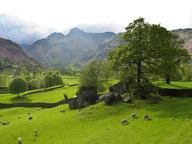Quiz Answer Key and Fun Facts
1. Bordered by River Calder & Worm Gill are several summits, but Wainwright only wrote about the highest, considering the others to be subsidiary summits. On which hill, accessible across 'Matty Benn's Bridge', did Alfred Wainwright commit an "unparalleled act of generosity"?
2. Scale Force is claimed to be the highest single waterfall in the District, dropping around 170 ft down a narrow cleft. On the northern side of which fell may this be found?
3. In 1887 Fanny Mercer tripped over her walking stick, fell and died while descending a mountain. A memorial was subsequently erected to her memory and the white cross still stands at Low Raven Crag. On which mountain did all this take place?
4. The hanging valley of Gillercomb forms southern side of Grey Knotts and the northern edge of which hill?
5. By what name is the summit of the fell Herdus (abbreviated from Herdhouse) known?
6. Which name is shared by two of the western fells, lying north and south of the River Liza as it flows through the Ennerdale forest, with summits only three miles apart?
7. At the summit of highest of the Western fells may be found a war memorial. Nearby is the Westmorland cairn and on one side may be found the rocky pinnacle known as Napes Needle. Which mountain is this?
8. From the Black Sail Youth Hostel, if you head west, past Looking Stead you have a choice of routes. The more elevated, runs above Green Cove, Hind Cove and Great Doup, whilst the lower (the 'High Level Route') runs below these features to Robinson's Cairn before passing over the Shamrock Traverse and offering a steep ascent to the summit. Which high fell does this all occur on?
9. Alfred Wainwright's ashes are scattered at Innominate Tarn, on his favourite fell. On which fell may this tarn be found?
10. To who, whom or what did Alfred Wainwright dedicate book 7 of his 'Pictorial Guide to the Lake District'?
Source: Author
paper_aero
This quiz was reviewed by FunTrivia editor
gtho4 before going online.
Any errors found in FunTrivia content are routinely corrected through our feedback system.
